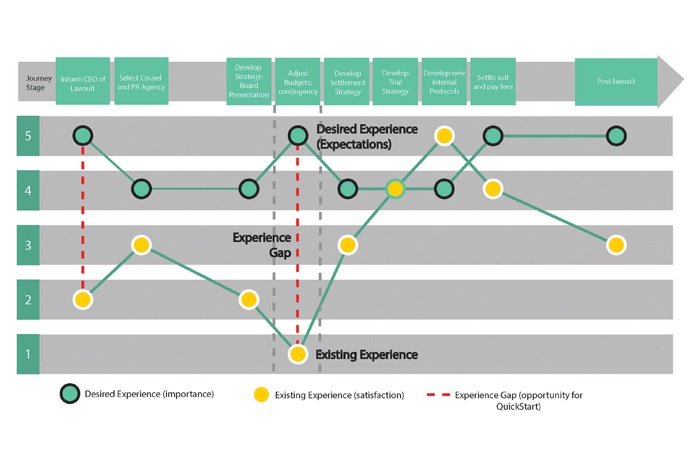I was recently corresponding with general counsel of a technology company who was bemoaning the lack of what he called ‘the basics’ from his law firms – understanding his company, the importance of the matter in the context of their situation, and how to best work with his team. I asked whether he provides feedback to them if they haven’t met his list of ‘basics’. ‘No,’ he said, ‘I just ghost them’.
As a business development and strategy consultant to law firms, I spend nearly half my time listening to partners discuss the increase in competition for legal work, the flat or reduced legal budgets of in-house counsel, and the rise of the procurement function. I tell them they can no longer rely on distinguishing themselves based solely on capabilities or expertise; that they have to focus on improving the client experience for in-house counsel.
I spend the rest of my time interviewing in-house counsel for articles, surveys, and client interview programs. While the majority are happy with most of the legal work they receive from their firms, most have complaints similar to those of the ghosting GC. Good to excellent legal acumen, but a lack of corresponding client service and client experience skills. And they always have a horror story of sorts to share with me.
Sometimes in-house counsel shorthand this by complaining about price. Yet when I dig deeper, the supporting comments clearly point to a lack of comparative value. One counsel, for example, indicated: ‘Way too much was charged, and the work-product was not on point. They didn’t listen well.’ Another corroborated: ‘It was the hourly rates and the amount of time spent on minor matters by senior attorneys charging the highest hourly rates… but not accomplishing any real results.’
An entire industry of procurement, pricing and project management has grown up around the increasingly obvious divide between what the clients want and what is being delivered. However, those efforts tend to be focused on negotiating lower rates (on the company side) and protecting the billable hour or profit margin (on the law firm side). They are not rooted in improving the actual experience of the in-house counsel when they work with outside law firms and lawyers.
Given the strong appetite of law firm lawyers to maintain their current client relationships, expand the work, and develop new relationships, you would think they would focus more heavily on developing these skills. The problem is not one of disinterest, however. Whenever I speak with partners, they espouse a belief in providing the highest quality of client service, and I believe they are earnest about it.
So what, exactly, is the disconnect? It’s as simple as not really understanding what in-house counsel truly need and what they actually do for a living. So what can you do as in-house counsel to get a better experience and work-product out of your firm?
The best way to help firms improve the client experience is to use a technique that forces them to experience their services from your point of view. One such technique, known as client journey mapping (CJM), has been used successfully by corporations across industries and around the world. There’s a good chance your company currently uses this technique with its own clients, and we’re beginning to see the most forward-thinking law firms use it to serve you better.
CJM, unlike process and project management mapping, is a visual representation of the steps and perceptions that you, as an in-house counsel, go through over a period of time to accomplish your goals. The law firm’s contribution is recast in a supporting role, in service of your broader goals, objectives, and activities.
The key to effective CJM is in its granularity. The firms don’t just listen to your objectives, or even your broad goals as an organisation, they are required to map out the steps you take in your role to accomplish an objective. This granular examination allows for more precise diagnosis, invites more specific conversations about places for improvements, and better reengineering that may include areas not normally addressed with other diagnostic tools. CJM helps identify the stages at which problems surface, as well as the stages of origination. It also helps identify the bright spots – all the places where the firm is performing well – and should be replicated elsewhere.
At PP&C Consulting, we have led CJM exercises with a number of firms; bringing in-house counsel into the room to work with partners and engage in this exercise. Counsel took an hour to describe a specific real matter in detail, stage by stage to their lawyers. In turn the partners had to map out the matter, identifying its various stages, as well as the expectations, challenges and potential new solutions for each stage of the matter. The partners indicated they not only gained a more nuanced understanding of the issues
in-housers faced at various stages of the matters discussed, but also a more sophisticated insight into the considerations and pressures that were top of mind for counsel. We are now speaking with several in-house counsel who are interested in engaging in a similar exercise during their own ‘law firm day’.
How exactly do you go about getting your firms to engage in this program and how do you implement it? Start small. Begin by bringing in a small number of lawyers from a firm or two. Put them in a room with members of your team. Ask your team to prepare a story about a recent matter handled by an outside firm. The team should stay away from generalities – outside counsel have heard them before and without specificity, they don’t have any reason to believe they are not being responsive, efficient and commercial. The team should also stay away from directly confronting the outside lawyers about matters they’ve handled. The team should describe the matter from their point of view, including details that do not touch upon the interactions with outside counsel.
Tell the outside lawyers listen and take notes. After hearing the stories, they should be able to both report back on the facts as well as the feelings (yes, feelings!) of your team members. They should then be tasked with identifying the source of the challenges the outside firms may have caused or could help to overcome. Working together with the in-house team, they should brainstorm ways in which firms can work more effectively. The stories and ideas for improvement should be documented. You can use formal mapping documents such as the ones shown or you can make your own.
The process may appear daunting at first – and this may seem like the latest marketing craze – but the concept behind it is really simple: the better a law firm understands your journey, the better positioned that firm will be to help you in a more sophisticated manner. Not only should you make law firms do this, they should want to do it. Better client experiences lead to higher satisfaction and the holy grail of client loyalty. That’s good for you, and good for them.
–
Yolanda Cartusciello served as the chief marketing officer at both Debevoise & Plimpton and Cleary Gottlieb Steen & Hamilton, and is now a partner at PP&C Consulting



